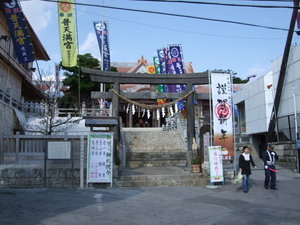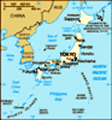Advertisement
Published: January 20th 2009

 Futenma Shrine
Futenma Shrine
You can see the torii gate protecting the outside of the shrine grounds.Today, I went with two of my friends to the Futenma Shrine for New Year (Hatsumode). Normally this would be done Jan 1-3 but this particular shrine seems to run the whole week after the 1st and it was a lot less busy when we went. I am not Shinto (and many of the other visitors aren't either) but this visit is an important part of Japanese culture and I am all about absorbing as much culture as I can.
Before you enter the shrine grounds, you walk through a torii gate. The gates are put in places of importance to keep bad luck and spirits away. When we first entered the shrine grounds, there is a little station you can stop at to drop off good luck charms (omamori) and twisted rope (shimenawa) from the previous year to be burned on the 15th of January. I was told by one of my Japanese friends that it is not mandatory to do this but she still recommended taking down the ones I had from the previous year. Since I am sentimental about everything, I did take mine down but have not given it over to be destroyed...I'll just put it

 Old Omamori/Shimenawa Station
Old Omamori/Shimenawa Station
This is where you drop off the charms and amulets from the previous year to be burned on January 15th.in my keepsake box (the omarori, not the shimenawa).
We headed up the stairs to the hand washing station. It is considered proper to cleanse your hands before entering the shrine grounds. You grab up one of these ladles and pour the water over the other hand, switching to wash both. You should not let your "dirty" water fall back into the main well of water...it should fall on the rocks to the side. There is an order to the process but as long as you get both hands clean, you are usually okay, even if you don't know the exact order. Like all shrines here, there are some kind of guardian on each side of the main building. In our case, they were Shisa dogs.
As you cross the plaza area towards the main shrine building itself, you can see several different stations and many of them are numbered...don't know if this indicates the order you are supposed to move in or not but I imagine when the place is jam packed like it is during the first three days, these are very helpful.
We walked up to the main shrine area. The doors are blocked

 Handwashing
Handwashing
This is where your cleanse your hands and face before entering the shrine.by little benches (so you can see in but not enter) and behind the benches are baskets or other containers to catch coins. Visitors are not allowed into the main building itself unless they have an appointment to see a priest or priestess. We walked up to the benches, bowed our heads, threw our money in the receptacle, made a wish or prayer, and then clapped our hands two times. I guess some shrines have a bell to ring before starting this (and ours might have too at the center section) but we were off to one side and I didn't see or hear any bell ringing. After that, we moved off to the side and continued with the visit.
On the left side of the main building, there were these racks of wooden plaques (ema). You could buy one and write a wish or prayer on it and hang it on the rack for it to come true. We didn't do this part since no one was at the station, but I did get some pictures of the racks and plaques. Next we bought a fortune (omikuji). It is a little paper slip that tells you either you

 Main Shrine Building
Main Shrine Building
Shisa dogs guard the sides and you can see some of the shrines shimenawa and the benches where we stood to toss our coins and clap.have great, good or not so good luck coming. Ours were in Japanese and even though one of us spoke Japanese, none of us read well enough to translate ours. You then fold it longwise 2 times and tie it to various ropes hanging on the shrine grounds. This helps the good things come true and helps keep the bad ones from happening. I am of course hoping, mine was a good one.
Next we headed over to the purchasing stalls to get our omamori for the year. I picked up a few different things....some for cars and some for home and person. I wanted to give my friend who doesn't live here anymore one (since she bought me my first one during her shrine visit last year). The priestess' working the stalls will bless the charms if they haven't already been blessed before you purchase them. These charms are available at other locations throughout the year but ones from the shrines are supposed to be blessed and therefore stronger than those you could get elsewhere.
Once we finished our purchases, we headed out. During Hatsumode, there are always food and trinket vendors along the path to exit

 Ema Racks
Ema Racks
These are the racks that hold the little wooden plaques that wishes or prayers have been written on.a shrine. The food is usually your typical Japanese festival food (although we got something I hadn't had before) and the other vendors will be selling items for the new year (this is the Chinese year of the Ox).
I am so glad I was able to go, and experience this part of Japanese culture I had yet to see. It was a great experience and I hope to do it again each New Year while I am here...
Advertisement
Tot: 0.111s; Tpl: 0.012s; cc: 9; qc: 55; dbt: 0.0549s; 1; m:domysql w:travelblog (10.17.0.13); sld: 1;
; mem: 1.2mb













Chicken
non-member comment
Cool
Very interesting!!